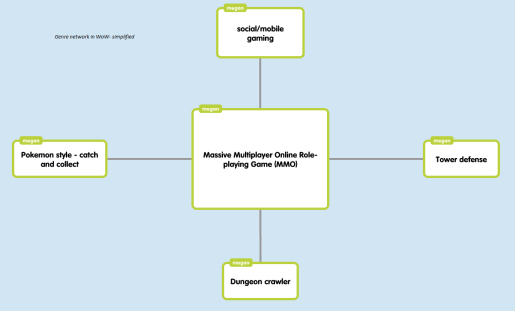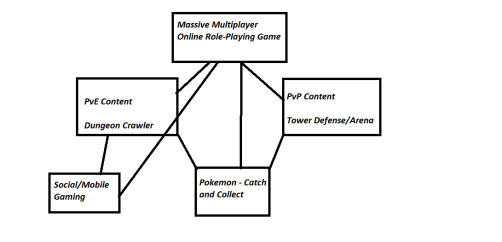Case Study #1 – Genre Theories in World of Warcraft
Pulling from the genre theories of Miller, Bazerman, and Popham, I’ll be looking at World of Warcraft as a network of genres that meets the needs of the community of players. Although there are layers of networks involved in the game, I’ll be specifically looking at the network of video game genres that WoW employs. The genres that World of Warcraft pulls from are based on player expectations built over time within the gaming community. For instance, WoW defines itself and is defined by the community as first a massive multiplayer online role-playing game (MMORPG). This acts as it’s official genre, however the game employs multiple genres that act as boundary objects to each other, helping to mediate the tensions created by the ever expanding game and community. By looking at the game as a meeting place of different pieces of a genre system (Bazerman), the theories articulate the game as a series of pieces that work with and against each other in order to create the game, especially since it continues to change over time as new genres are introduced to the game over time through software patches and expansions.

The chart shows a very simplified version of the genres at work within World of Warcraft. The central node is the MMORPG, as that is the genre that WoW attempts to subscribe to in name and through marketing. However, expectations for this particular genre are vast primarily because it tells us so little. We know the game is a massive multiplayer game and the RPG element primarily comes from fantasy world setting. The RPG element also is pulling from previous work in RPG games that is quite diverse, especially over time. WoW doesn’t only have one particular chronological setting since it is continually updated in small software patches, but also in large expansion packs every few years which allows it continue to change in multiple ways, including in expectations of the RPG genre. Some features of this genre include mana and health bars and control of individual character that involves customization of character and that the character fits into a larger narrative framework created by the game and the player. This specific node features prominently in the eye of the gaming community and allows a lot of flexibility. It provides boundary object for other genres incorporated into the game to bump up against and create tension as well as provide new possibilities for the player.
The other genres incorporated into the game have specific roles in game play, and often different types of players categorize themselves as certain types of player in terms of the secondary genres. For instance, most players identify as a dungeon/raider player, or a PvE (player vs. environment) content player which fits into the dungeon crawler genre or as a PvP (player vs. player) content player, similar to the tower defense genre. It is possible to strip this down further to cooperative (PvE vs. PvP) competitive play styles, but this is very simplified as it ignores that both types of play incorporate cooperative and competitive play elements. However, these types of play are both integral to the WoW community and meeting the needs of players. They create tension between each other, but both help to define the MMORPG genre as encompassing both types of game play as well as giving players multiple outlets for play. The game also incorporates the use of quests from the dungeon crawler genre for players to experience both dungeon crawler and tower defense elements at the same time.
The game also incorporates other genres in smaller areas of game play such as the inclusion of social games or Pokemon style of catch and collect. While Pokemon typically falls into the role-playing game genre, there is argument in the community that it has created its own genre that has been copied and employed in other games as well. For WoW, I specifically thought of the pet collecting feature that allows players to travel around Azeroth catching little animals called companion pets. WoW also implemented a battle system where the player can play against non-playable characters (NPCs) or other people, very similar to Pokemon. Even community members often call it Pokemon.
 Specifically in more recent expansions, secondary genres have emerged within the game and gained more agency, such as the Pokemon style of catch and collect. As players have expressed interest in these types of genres incorporated into the larger framework of the game, achievements and prizes for completion have been added. A genre like the social/mobile gaming genre being implemented into the game, such as through the follower mini game in the garrison, has been met with very mixed reviews from the community. The agency of the nodes seems primarily connected with audience response, particularly to how they see the genre meshing or disrupting their genre expectations when playing. The nodes are situated in a hierarchy that respond to the primary defining genre, as well as the two genres that players typically categorize themselves under. There are more genres within game play, but the fall under the main genre of MMORPG, and then under either the PvE or PvP content genres, sometimes connecting the two in some ways such as the Pet catch and collect/Pokemon genre that exists in the game that allows players to stay entirely in the PvE content genre or mix it with the PvP content genre. The smaller genres that begin to appear and become categorized under the different content genres allow the overall genre of MMORPG to expand. When there is too much of a cognitive dissonance between the overarching genre of MMORPG however, the tertiary genres may experience tensions and possibly die out because players refuse to engage or complain openly within the community. Since the genre is to serve community, this dissonance means that the genre may dissolve from non-use, but also may be taken out of the game by developers.
Specifically in more recent expansions, secondary genres have emerged within the game and gained more agency, such as the Pokemon style of catch and collect. As players have expressed interest in these types of genres incorporated into the larger framework of the game, achievements and prizes for completion have been added. A genre like the social/mobile gaming genre being implemented into the game, such as through the follower mini game in the garrison, has been met with very mixed reviews from the community. The agency of the nodes seems primarily connected with audience response, particularly to how they see the genre meshing or disrupting their genre expectations when playing. The nodes are situated in a hierarchy that respond to the primary defining genre, as well as the two genres that players typically categorize themselves under. There are more genres within game play, but the fall under the main genre of MMORPG, and then under either the PvE or PvP content genres, sometimes connecting the two in some ways such as the Pet catch and collect/Pokemon genre that exists in the game that allows players to stay entirely in the PvE content genre or mix it with the PvP content genre. The smaller genres that begin to appear and become categorized under the different content genres allow the overall genre of MMORPG to expand. When there is too much of a cognitive dissonance between the overarching genre of MMORPG however, the tertiary genres may experience tensions and possibly die out because players refuse to engage or complain openly within the community. Since the genre is to serve community, this dissonance means that the genre may dissolve from non-use, but also may be taken out of the game by developers.
The genre theories provide affordances in that they helped me consider the hierarchy of genre that exists within the game of World of Warcraft. However, there were also some limitations in discussing the agency that individual players vs. developers have in the creation, emergence, growth, and dissolution of the networks. It also ignored the ways that specific social networks are built in relation to these genres, which is something I’m really interested in discussing in further case studies.
Works Consulted
Bazerman, Charles. “Systems of genres and the enactment of social intentions.” Genre and the New Rhetoric. Eds. Aviva Freedman and Peter Medway. London: Taylor & Francis Ltd, 1994. Print.
Blizzard Entertainment. World of Warcraft: Warlords of Draenor. Activision Blizzard, 2012. Online.
Popham, Susan L. “Forms as Boundary Genres in Medicine, Science, and Business.” Journal of Business and Technical Communication 19 (2005): 279-303. Print.
February 25, 2016 at 2:21 am
I like the fact that you are applying genre theory to game playing. Genre theory is the most familiar theory to me so far, and one that I know for sure that I’m going to use for my dissertation. I’ve done genre studies of reports to the National Academy of Science on oceanography, modern language textbooks, and English and communication department web pages in university websites, but using genre theory to look at video games was an interesting new idea for me. It was particularly intriguing that you were theorizing it in terms of a genre system. I also love the boundary object idea. I was a little confused by the terminology since about the only games I’ve played very few video games of any kind and never even tried multiplayer games. I don’t know what an RPG element is, for example. What I would like to see more of, I think, is the explicit application of genre terminology to the game environment, or maybe I should say genre concepts, since genre theory doesn’t have too much terminology. Of course it is possible that you have done precisely that and that it is my lack of familiarity with the game that makes it a little less transparent for me. At any rate, as I said, I enjoy seeing genre theory applied to an OoS that is a little more exotic for me.
LikeLike